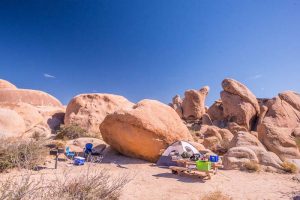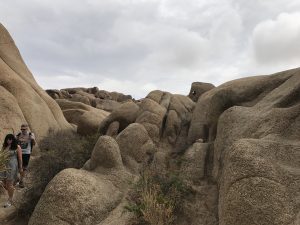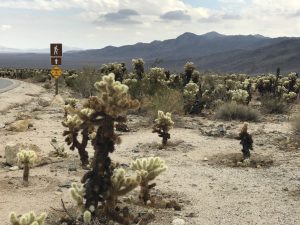
Camping for a honeymoon at Joshua Tree
TWENTYNINE PALMS, Calif. — Camping is one of the best ways to embrace Joshua Tree National Park, easily reachable from either Los Angeles or Las Vegas.
The higher and cooler Mojave Desert is the special habitat of Joshua tree, whose scientific name is Yucca Brevifolia. Combined with giant boulders and rocks, the national park near here demonstrates the distinct desert landscape to attract many camping lovers and traveling explores each year.
| Desert rock formations are highlights at the campgrounds in Joshua Tree National Park in California (Photos by Chu Zhang). |  |
There are nearly 500 campsites in the park, most of them are first-come, first-served. However, Black Rock and Indian Cove campgrounds require reservations during the busy season from October through May.
Other popular campgrounds include Ryan, Belle, White Tank, Jumbo Rocks and Cottonwood. Sheep Pass, Cottonwood and Indian Cove are the three areas that support group campsites, which can accommodate 10 to 60 people.
My friend Lorina Liu and I drove into the park from Las Vegas and we were amazed by the Joshua trees and their natural charm.
“I’ve never seen the tree like this,” I told her. “they look like fashion models posing in different postures.”
“Then the rocks and wildlife form the background of runway,” Liu replied.
When we arrived at the Belle campground, it was almost at noon. We prepared some simple sandwiches and fruit for lunch. This was also the place we met a camping couple from China, Lu Wang and her husband Wenyu Li.
“This is our first time traveling in the United States,” Wang said. “He wants to make up our honeymoon for a long time.”
She was excited to see us, also as Chinese citizens, in such a remote area, so we talked and spent the whole afternoon together.
While we were talking with Wang, her husband Li was trying to set up the tent.
“At least the weather is not so hot,” Li laughed at himself. “The tent is not friendly for a beginner like me.”
Camping is not easy, however. It requires what seems like a lifetime of experience to find a comfort zone. Wang and Li got married two years ago in Beijing. Due to Li’s special working conditions at that time, they did have an ideal schedule for a honeymoon.
“Working from 8 a.m. to 5 p.m., not including the horrible traffic in peak rush hours, can you image how we repeat days like that for two years?” Li said, while opening the sleeping pad and sleeping bag.
 |
The desert rocks near the campgrounds often provide scenic spaces for hiking in the park. |
Indeed, people need to spend time in nature in places like Joshua Tree National Park, to forget the sophisticated and often hectic city life.
“We prepared for camping at a national park in the U.S. for almost a year,” he continued. “We compared these wonderful national parks many times in terms of the safety, climate, food supply, wild animals and so forth.”
They finally choose Joshua Tree and the Grand Canyon to open their camping world.
“We always remind ourselves to push the comfortable zoo, even traveling in a foreign country could face many unexpected problems.” Wang told us.
“Joshua Tree’s campgrounds are relative flat and located in fair elevation” Li explained. “We love Cottonwood campground so much because it has water and flush toilets, but the updated news shows it will close from June 6 to Oct. 2. “
The Cottonwood campground has 62 sites, famous for its breathtaking night sky views and near hike trail to Lost Palms Oasis and Cottonwood Springs.
“While Belle (Campground) was the start of the all other campgrounds, we don’t go back and forth to the attractions,” he added.
“Why don’t you rent a RV, it may be more comfortable for the first-time camping in a national park,” my friend Liu asked.
“We want to live the way that Americans do,” Wang laughed. “I really appreciate their life attitude, feel free to experience adventure.”
“No doubt, an RV is more safe and comfortable, but we have never tried sleeping in a tent,” Li added.
“Definitely, Joshua’s view is unique enough that you can’t have similar view from any other park,” I said. “it is the first time that I am so surprised to see these rocks and trees and I have lived in U.S. for six years.”
Wang brought more beverage to share with us.
“We searched tons of camping tips. The biggest lesson we remembered is to bring enough water,” he said.
| Joshua trees are commonplace, even along the park’s roads. |  |
More interestingly, Wang showed us her wedding dress from the suitcase that they brought to shoot the honeymoon pictures. “Experiencing these crazy ideas made me so happy when it really came true,” she smiled. “My understanding of a wedding changed a lot in this two years after we married.”
From her face, I could see the peace in her heart. As we grow up with more responsibilities and material temptations, someday we will finally realize the life we want to live.
“Enjoying the sun at a beach may be relaxing, but hugging with your lover in a sleeping bag and worried about whether a wild animal will show up at night means more for me,” Wang said.
The families who camped next to the couple went to our table and invited us to their bonfire at night.
“Hopefully we can see the stars tonight. The weather was not good last night,” Steven Watkins said, father of the family. “My friend told me Belle has extensive ground to enjoy the stars.”
Liu and I could not stay for their bonfires, but I can still imagine the fantastic boulder “art piece” standing with Joshua trees when the light from campfire illuminates them against the dark sky.
If You Go
Joshua Tree National Park
Address: 74485 National Park Dr., Twentynine Palms, Calif. 92277-3597.
Directions: From I-10, take exit 117 for California Hwy. 62 toward 29 Palms/Yucca Valley. This will allow access the West Entrance, the North Entrance, Black Rock and Indian Cove. Take exit 168 off I-10 to come in at the park’s South Entrance.
Operating hours: The park opens 24 hours a day, some trails are closed at night.
Fees & Passes:
Entrance fees:
- $25, seven-day vehicle permit, admitting the passengers of a single, non-commercial vehicle on the day of purchase and for the next six days.
- Motorcycle or Bicycle Entrance: $12, seven-day entrance permit per motorcycle or bicycle.
- Walk-in Entrance: $12, seven-day entrance per person on foot.
- Non-commercial groups: $12 per person to non-commercial groups entering in a vehicle with a capacity of 16 passengers or more.
Entrance Passes: $40 annual pass, is valid for or 12 months from the month of purchase. It covers the entrance fee to Joshua Tree National Park for the pass signee and accompanying passengers entering in a single, non-commercial vehicle. Joshua Tree annual passes are available at park entrance stations and visitor centers.
Campgrounds:
- Belle: 18 sites, $15 per night, 3,800 feet in elevation. The facilities include pit toilets, tables and fire grates.
- Cottonwood: 62 sites, $20 per night, 3,000 feet in elevation. The facilities include water, flush toilets, tables, fire grates and a dump station.
- Hidden Valley: 44 sites $15 per night, 4,200 feet in elevation. The facilities include tables, pit toilets and fire grates.
- Black Rock: 99 sites, $20 per night, 4,000 feet in elevation. The facilities include water, flush toilets, tables, fire grates and a dump station.
- Indian Cove: 101 sites, $20 per night, 3,200 feet in elevation. The facilities include tables, pit toilets and fire grates.
- Jumbo Rocks: 124 sites, $15 per night. 4,400 feet in elevation. The facilities include tables, pit toilets and fire grates.
- Ryan: 31 sites, $15 per night, 4,300 feet in elevation. The facilities include tables, pit toilets and fire grates.
- White Tank: 15 sites, $15 per night, 3,800 feet in elevation. The facilities include tables, pit toilets and fire grates.
Pets:
Pets must remain on leashes at all times and may not be left unattended
https://www.nps.gov/jotr/planyourvisit/pets.htm
Equestrian Camping:
Black Rock and Ryan Campgrounds have designated horse camps (Ryan is closed in the summer months).
The horse riding page: https://www.nps.gov/jotr/planyourvisit/horseback-riding.htm
More regulations:
https://www.nps.gov/jotr/planyourvisit/camping-regulations.htm

Comments are Closed